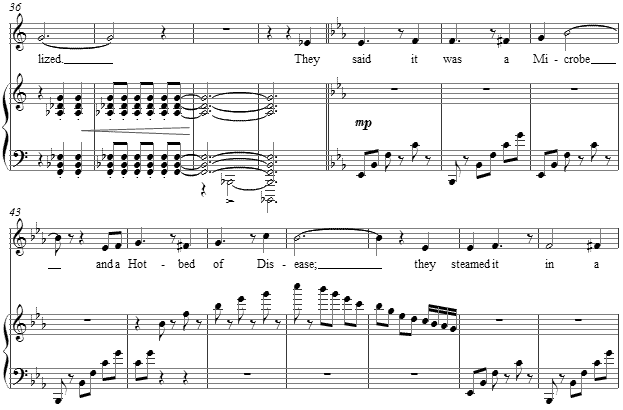Music and Texts of GARY BACHLUND
Vocal Music | Piano | Organ | Chamber Music | Orchestral | Articles and Commentary | Poems and Stories | Miscellany | FAQs
Strictly Germ-Proof - (2008)
Arthur Guiterman
for medium voice and piano
The Antiseptic Baby and the Prophylactic [ 1 ] Pup
Were playing in the garden when the Bunny gamboled up;
They looked upon the Creature with a loathing undisguised; —
It wasn't Disinfected and it wasn't Sterilized.
They said it was a Microbe and a Hotbed of Disease;
They steamed it in a vapor of a thousand-odd degrees;
They froze it in a freezer that was cold as Banished Hope
And washed it in permanganate [ 2 ] with carbolated soap [ 3 ].
In sulphurated hydrogen [ 4 ] they steeped its wiggly ears;
They trimmed its frisky whiskers with a pair of hard-boiled shears;
They donned their rubber mittens and they took it by the hand
And 'lected [ 5 ] it a member of the Fumigated Band.
There's not a Micrococcus [ 6 ] in the garden where they play;
They bathe in pure iodoform [ 7 ] a dozen times a day;
And each imbibes his rations from a Hygienic Cup --
The Bunny and the Baby and the Prophylactic Pup.[ 6 pages, circa 3' 00" ]
Illustration from The Laughing Muse (1915)
Arthur Guiterman (1871-1943) was the co-founder of the Poetry Society of America, and served as its President 1925-26. This humorous text was published in The Laughing Muse (New York and London: Harper & Brothers Publishers, 1915), after being first published in Women's Home Companion (1906), which Guiterman served as editor. Born in Vienna, Austria, of American parentage, the family returned to the United States, and Guiterman graduated at the College of the City of New York in 1891. Mr. Guiterman did editorial work on the Literary Digest from 1891 to 1906, and published several books of verse, including Betel Nuts (1907), The Laughing Muse (1915), The Mirthful Lyre (1917), Ballads of Old New York (1920), The Light Guitar (1923), Wildwood Fables (1927), and Gaily the Troubadour (1936).
Written for medium voice and a reasonably short tessitura, the setting of this humorous text begins with parallel descending clusters, diatonic and therefore rather consonant in their dissonance. The 3/4 time feeling makes light of the strange tale's characters, which belie our own human penchant for sometimes neurotic cleanliness.
Highlighting the phobia, repeated chords emphasize the fear in a comic way, as the second stanza veers away from the tonic to the lowered mediant.
Again the tonal region veers away from one center to the next, as the second strophe is not completed in the same manner as the first. Agitation is among the emotional colors of this phobia, set in syncopations and a refusal to remain within a tonal region for too long. At the last strophe a reprise of the opening is realized and a final "descent" to the tonic C.
The score for Strictly Germ-Proof is available as a free PDF download, though any major commercial performance or recording of the work is prohibited without prior arrangement with the composer. Click on the graphic below for this piano-vocal score.
NOTES
[ 1 ] Prophylactic, adj. meaning "protecting from or preventing disease." That a puppy might be thought of as in anyway prophylactic is humorous, in of itself.
[ 2 ] Permanganate: a salt of permanganic acid: a salt of carbolic acid. Permanganic acid (HMnO4), calcium salt or Calcium permanganate, Ca(MnO4)2
[ 3 ] Soap impregnated with carbolic acid.
[ 4 ] "Sulphurated hydrogen" refers to hydrogen sulfide, a colorless, flammable poisonous gas that has a characteristic and very pronounced rotten-egg odor, is formed in the decomposition of organic matter containing sulfur, and is still used as an antiseptic, a bleach, and a reagent. Guiterman hopes we might imagine with our noses the awful stench.
[ 5 ] "Elected," the letter L missing in the manner of linguistic contractions.
[ 6 ] Micrococcus: a spherical-shaped bacterium, usually found on the skin of mammals, which is a genus of bacteria in the Micrococcaceae family. Micrococcus is generally thought of as harmless bacterium, though modern immune-deficiencies make even a "harmless" bacterium life-threatening.
[ 7 ] Iodoform is a compound of iodine used as an antiseptic. The compound iodoform is CHI3. A pale yellow, crystalline, volatile substance, it has a penetrating odor (in older chemistry texts, the smell is sometimes referred to as the smell of hospitals) and, analogous to chloroform, sweetish taste. It was used in medicine as a healing and antiseptic dressing for wounds and sores around the beginning of the 20th century, though this use is now superseded by better antiseptics.



